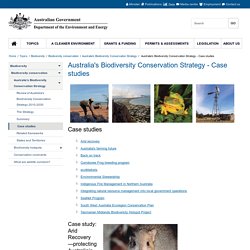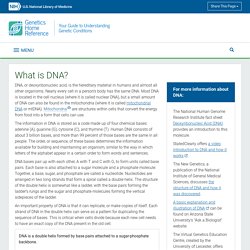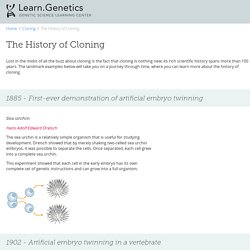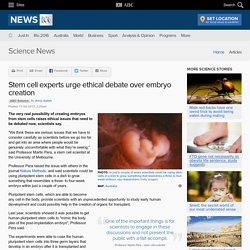

Prokaryotic Vs. Eukaryotic Cells. The Three Domains of Life. Bacteria. Archaea. KS3 Bitesize Science - Disease : Revision, Page 3. Comparing Mitosis and Meiosis. Cell Cycle, Mitosis and Meiosis. The National Strategy for the Conservation of Australia's Biological Diversity - public submissions. A burrowing bettong, one of the four threatened species successfully reintroduced into the reserve (Photo: S.

Lyon) Case study: Arid Recovery—protecting Australia’s threatened animals and ecosystems Arid Recovery is a unique partnership between industry, government, education and the community. Located near BHP Billiton’s Olympic Dam mine in northern South Australia, Arid Recovery is an ecosystem restoration initiative based around one of Australia’s largest fenced reserves, from which all feral cats, foxes and rabbits have been removed. The reserve straddles the BHP Billiton special mine lease and sections of five pastoral properties, and covers a total area of 123 square kilometres. Arid Recovery was initiated in 1997 by a partnership comprising BHP Billiton, the South Australian Department for Environment and Heritage, The University of Adelaide and a community group, Friends of Arid Recovery.
Agriculture, Kununurra, WA(Photo: Nicole Middleton) Case study: Australia’s Farming Future. Amazing! Aphid cloning - Battle of the Animal Sexes - BBC Wildlife. Somatic cell nuclear transfer. In genetics and developmental biology, somatic cell nuclear transfer (SCNT) is a laboratory technique for creating an ovum with a donor nucleus.

It can be used in embryonic stem cell research, or in regenerative medicine where it is sometimes referred to as "therapeutic cloning. " It can also be used as the first step in the process of reproductive cloning. In SCNT the nucleus, which contains the organism's DNA, of a somatic cell (a body cell other than a sperm or egg cell) is removed and the rest of the cell discarded. At the same time, the nucleus of an egg cell is removed. What is DNA?
What is DNA? - Genetics Home Reference. DNA, or deoxyribonucleic acid, is the hereditary material in humans and almost all other organisms.

FS1 INTRODUCTION TO DNA GENES AND CHROMOSOMES. Alleles - Biology Video by Brightstorm. An allele is one of the possible forms of a gene.

Most genes have two alleles, a dominant allele and a recessive allele. If an organism is heterozygous for that trait, or possesses one of each allele, then the dominant trait is expressed. A recessive allele is only expressed if an organism is homozygous for that trait, or possesses two recessive alleles. Alleles were first defined by Gregor Mendel in the law of segregation. When studying heredity one of the most common things to mess up is the terms gene and allele. Cloning Fact Sheet - National Human Genome Research Institute (NHGRI) Cloning What is cloning?

The term cloning describes a number of different processes that can be used to produce genetically identical copies of a biological entity. Animal Cloning > A Primer on Cloning and Its Use in Livestock Operations. The responses to the questions provided in this document represent the FDA’s view in light of the conclusions and recommendations outlined in the Animal Cloning Risk Assessment, Risk Management Plan, and Guidance for Industry #179.

What is cloning, really? What can go wrong with cloning? Why is there interest in cloning? Is it safe to eat food from clones? The History of Cloning. Sheep Ian Wilmut and Keith Campbell In this landmark experiment, Wilmut and Campbell created a lamb by transferring the nucleus from an adult sheep's udder cell into an enucleated egg.

Never before had a mammal been cloned from an adult somatic cell. Stem cell experts urge ethical debate over embryo creation - Science News. Posted The very real possibility of creating embryos from stem cells raises ethical issues that need to be debated now, scientists say.

"We think these are serious issues that we have to consider carefully as scientists before we go too far and get into an area where people would be genuinely uncomfortable with what they're seeing," said Professor Martin Pera, a stem cell scientist at the University of Melbourne. Professor Pera raised the issue with others in the journal Nature Methods, and said scientists could be using pluripotent stem cells in a dish to grow something that resembles a three- to four-week embryo within just a couple of years. Pluripotent stem cells, which are able to become any cell in the body, provide scientists with an unprecedented opportunity to study early human development and could possibly help in the creation of organs for transplant.
GCSE Bitesize: Inheritance - higher. Allele frequency. DNA Structure and Function. Co-dominance and Incomplete Dominance. Youtube. DNA Replication Animation - Super EASY. DNA Replication [HD animation] DNA replication and RNA transcription and translation. The different types of mutations. An introduction to genetic mutations. Mutations: The Potential Power of a Small Change. GRADUALISM & PUNCTUATED EQUILIBRIUM. ATryn is a recombinant antithrombin indicated for the *prevention* of peri-operative and peri-partum thromboembolic events in hereditary antithrombin deficient patients.
Insecticidal Plants: The Tech and Safety of GM Bt Crops - Science in the News. By Matthew Niederhuberfigures by Kaitlyn Choi Summary: Bacillus thuringiensis (Bt) is a common bacteria that has played a very uncommon role in agriculture and the development of genetically modified foods.

The natural insecticidal abilities of these bacteria have made them an important pest control tool for nearly a century. While their use as a natural biopesticide is widely accepted and approved for organic applications, the engineering of Bt genes into major crops has been more controversial. Protecting our food from pests has been an ongoing battle ever since humans began cultivating food. The U.S. However, with the advent of genetic engineering, new highly targeted strategies for pest control have become available in the form of transgenic plants that are designed to have insecticidal traits. Since the 1990s, corn and cotton with Bt genes have become the predominant varieties planted in North America [3]. So what exactly do we know about the safety of Bt crops? Natural Selection - Crash Course Biology #14. Transcription and Translation: From DNA to Protein.
Protein Synthesis and the Lean, Mean Ribosome Machines. DNA replication - 3D. From DNA to Protein. Genetic Dominance. Updated February 08, 2017 Genetic Dominance Genetic Dominance Have you ever wondered why you have that particular eye color or hair type?

It's all due to gene transmission. As discovered by Gregor Mendel, traits are inherited by the transmission of genes from parents to their offspring. Videos / What is Evolution? - Stated Clearly. Videos / What is Natural Selection? - Stated Clearly.